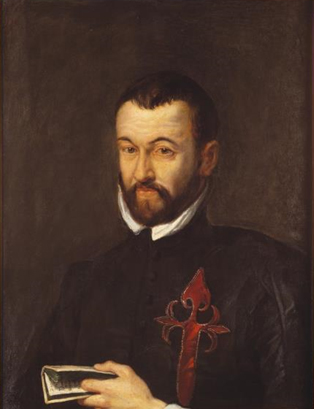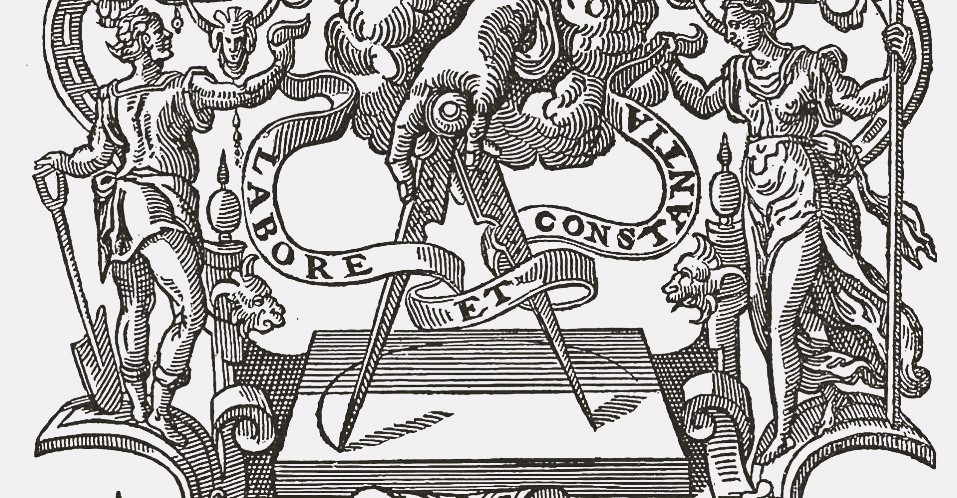
Benito Arias Montano was born in Fregenal de la Sierra (Badajoz, Spain) sometime between 1525 and 1527. He studied at the universities of Seville and Alcalá, where he finished his theological studies in 1552. He entered the aristocratic Order of Santiago in 1560 and two years later was selected by the Bishop of Segovia, Martín Pérez de Ayala, to join the Spanish delegation at the Council of Trent. The consequence of his brilliant participation brought him an appointment as chaplain to Philip [Felipe] II.
Undoubtedly Arias Montano’s most important achievement was the direction of the Biblia Regia (also known as the Antwerp Polyglot), commissioned by Philip II from the printer Christopher Plantin. In 1568 he moved to the Low Counties where he devoted himself to the editing and supervision of this colossal work. His activities were not confined to the Polyglot Biblebetween 1569 and 1571 he coordinated the preparation of the catalogues of forbidden and expurgated books that came under the auspices of the Duke of Alba; throughout the seven-year period away from his homeland, he acquired by royal order books and manuscripts for the newly founded library of the monastery of San Lorenzo de El Escorial; and from 1571 he supervised the administration and printing of the prayer books (breviaries, missals, diurnals, and hours) that Plantin published for the Spanish Crown under a contract signed with Philip II. Montano was even involved actively in a number of important political decisions made by the Spanish king, who valued greatly the advice of his chaplain.
In July 1576, Arias Montano returned to Spain and in March of the following year he arrived at El Escorial to organize and catalogue the Royal Library. This task extended until 1592 and involved four stays in the monastery interrupted by periods during which he retired to La Peña de Aracena, as well as by work on several official commissions. In 1592 he returned to Seville and remained in Andalusia until his death on 6 July 1598.
Arias Montano represents the ideal type of humanist of the sixteenth century. His interests were varied and included botany, geology, physics, medicine, architecture, and painting. He wrote prose and verse, and as a theologian and a biblical scholar he produced in prose a series of exegetical works, Latin translations of the Bible, and theological treatises; but an amazingly fertile poetic impulse also impelled him to compose great lyrical works, didactic poems in hexameters, and translations in verse. He was an inveterate bibliophile and used his contacts with the Plantinian press to provide costly book orders to a humanist circle to which prominent figures of Spanish Golden Age, such as Francisco Pacheco and Fernando de Herrera, belonged. He was a gifted linguist and—in addition to Latin, Greek, and Hebrew—he mastered several modern languages (including Italian and French, in which he wrote a number documents). The talents of this prestigious scholar were brought to bear in his most important work, the literal text of the Bible.
The project of editing all of Arias Montano's correspondence has frustrated many researchers over the past century. Regarding the location of new letters, the most important difficulty is the extreme dispersion of the material. The main sources of Arias Montano's letters are three archives whose geographical axis crosses Europe from north to south: the Royal Library in Stockholm, the Museum Plantin-Moretus in Antwerp and the Archivo General de Simancas (Valladolid, Spain). Approximately sixty percent of Montano's known letters are preserved in these three points, but to get to the rest of the letters one have to visit archives scattered throughout Spain, as well as Portuguese, Italian, Dutch, Belgian, Polish, British, and americans librarries. As for the edition of the text, it is also a painful task to gather all the possible sources (handwritten or printed) of each letter. Furthermore, we must face the last challenge, namely the paleographical difficulty of some of this correspondence, especially the drafts. It is true that we are already aware of several hundred letters published in articles and collections of different chronology and of different quality, and that we even have news that in this or that archive there are unpublished letters. But until now, a joint and modern edition of this correspondence has not seen the light of day, which is undoubtedly necessary for a thorough knowledge of 16th-century Spanish-Flemish humanism. And if we take stock, it turns out that during the 19th century more letters from Arias Montano were published than in the 20th century: the monograph on Carvajal, the Colección de documentos inéditos para la historia de España,part of the Correspondance de Christophe Plantin, and the letters of Ovando and Ortelio edited by Jiménez de la Espada and Hessels, respectively, were published in the 19th century.
It must also be said that if an edition of this epistolary has not already appeared, it has not been for lack of trying: we know that Luis Morales Oliver, in the preparations for his Arias Montano y la política de Felipe II en Flandes, from 1927, planned to visit several European libraries in search of new letters; in any case, he only used three previously unpublished letters as raw material for his monograph (two of them are at Instituto de Valencia de Don Juan and one at the University of Seville). The scholar who put real effort into compiling and publishing Montano's correspondence was the Dutch Romanist Ben Rekers, who published two catalogs of Montano letters in 1960 and 1973. His catalogs are an obligatory starting point for any new prospecting. In the mid-1980s, Professor Antonio Holgado also designed an ambitious publishing project for the Montanian correspondence based on a variety of material he received from the Fundación Universitaria Española through Gregorio de Andrés; Around the same time, Danielle Domenichini, a roman scholar from the University of Pisa, shared efforts with Holgado. In the mid-nineties of the last century, professors Juan Gil, from the University of Seville, and José María Maestre, from the University of Cádiz, took over from Holgado, giving great impetus to their plans. This impulse has materialized in the co-direction of the two doctoral theses that provide the most unpublished letters from the great collections of the 19th century: first, Baldomero Macías' edition of the correspondence of the Stockholm manuscript on the Polyglot, published in 1998; and second, in 1999, the doctoral thesis of the person directing this project entitled La correspondencia de Arias Montano conservada en el museo Plantin-Moretus de Amberes. Other members of the research group "Elio Antonio de Nebrija" group, such as Luis Charlo and Enrique Morales, have continued to publish new letters from Montano throughout the first decade of this century (see the page on the Publications). In the years 2017 and 2022, the first two printed volumes of Arias Montano's correspondence, edited by Juan F. Domínguez Domínguez were published, which include Montano's letters from the period from 1560 to 1572, with a great profusion of notes and appendices, and that announce the continuity of the project in the coming years. We sincerely welcome this new printed edition, because, as can be seen from the bibliographical overview of this paragraph, the figure of Benito Arias Montano is so great and his epistolary is so varied that they deserve - and surely need - more than one editor.
What matters, at the end of the day, is that all these renewed efforts from the end of the 20th century come together, sooner or later, in the long-awaited joint edition of Arias Montano's correspondence which, as can be deduced from the previous lines , has been and continues to be a complex task and a true philological challenge. The proposal of our team, based on the multiple letters from Montano already published in our previous paper publications, is to bring together in a digital and online edition both the already published letters and the new ones that may appear. We are convinced that the new standards and resources for the philological edition of the Digital Age can provide us with ideal solutions for the difficulties of publishing Arias Montano's correspondence. Likewise, the digital publication provides a much deeper and richer dimension than the traditional print: with this project we offer a dynamic digital critical edition that includes the facsimiles of most of Arias Montano's letters; we provide different perspectives of the letter text for each type of reader (XML document, text with markup display, annotated translation, text without markup display); the filters and search engines incorporated into the edition allow search possibilities far superior to those of paper or PDF; and, last but not least, with our online edition the interested reader will be able to access without barriers and instantly the latest possible level of updating of the critical edition, translation and notes of the text of Arias Montano's letters.
